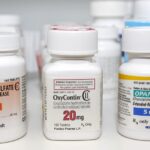The Emergence of Ultra-Potent Synthetic Opioid ‘Nitazenes’ Raises Alarming Concerns Amidst Opioid Crisis

In recent times, the opioid crisis has been further exacerbated by the appearance of illicit street fentanyl, a bootleg variant of a potent prescription painkiller. However, experts are now sounding the alarm about a potentially even more perilous synthetic opioid, nitazenes, infiltrating the illegal drug market.
A recent investigation has revealed that nitazenes surpass fentanyl’s danger by a significant margin, as they are approximately 1,000 times more potent than morphine and a striking ten times more potent than fentanyl itself.
The heightened potency of nitazenes poses a severe threat because it takes only a minuscule amount of these substances to produce the same effects as larger quantities of other opioids, making overdose a more imminent risk, according to Alexandra Amaducci, the lead researcher and an expert in emergency medicine and medical toxicology at Lehigh Valley Health Network-USF Morsani College of Medicine in Bethlehem, Pa.
What amplifies the risk further is that nitazene-related overdoses appear to be not only more severe but also more challenging to treat compared to fentanyl overdoses.
Originally developed in the 1950s as a pain medication, nitazenes never received approval for medical use. Over the decades, these drugs faded from medical attention. However, during the early stages of the pandemic, various forms of nitazenes—powder, tablets, and liquid—began infiltrating the illicit drug supply, re-emerging as a substantial concern.
Since then, over 200 nitazene-related overdose deaths have been reported across North America and Europe, though experts suspect this number may be an underestimate due to inadequate nitazene testing.
To gain insights into the threat posed by nitazenes, Amaducci’s team analyzed medical records of a small group of patients treated at an emergency department for nitazene overdoses between 2020 and 2022. This group consisted of four men and five women, aged 20 to 57, among a larger cohort of approximately 2,300 overdose patients, of which 537 underwent comprehensive lab testing. Of these, just under 2% (nine patients) tested positive for nitazene opioids, including brorphine, isotonitazene, metonitazene, and/or N-piperidinyl etonitazene. In comparison, a slightly larger group of 11 patients tested positive for fentanyl.
The severity of overdoses was assessed by comparing the amount of naloxone required to treat each patient. Naloxone is an opioid antagonist administered through injection or nasal spray, which can rapidly reverse the effects of opioids and restore breathing in overdose cases.
According to Amaducci, nitazene overdoses appeared to be more severe than heroin and fentanyl overdoses because patients needed significantly higher doses of naloxone to counteract the overdose effects.
One theory is that regulations aimed at curbing illicit fentanyl production may have driven drug dealers to seek alternative, less easily detectable substances.
Amaducci hopes that these findings will raise awareness among patients and the public about the presence of nitazenes in the illicit drug supply, highlighting the heightened risk of overdose and the need for more extensive treatment to reverse it.
The study’s results were published online on August 29 in JAMA Network Open.
Dr. Ramin Mojtabai, a mental health professor at the Johns Hopkins School of Public Health in Baltimore, emphasized that people who consume illicit opioids are typically unaware that the drugs they believe they are taking may be tainted with something as potent as nitazenes.
Mojtabai explained, “All opioids can cause respiratory and cardiac arrest and be fatal at higher doses. But with more potent opioids, these adverse effects can happen after using a very small amount of the drug.”
He stressed that most individuals exposed to these synthetic opioids take them unknowingly, as these drugs are often mixed with other illicit substances. This lack of familiarity with extremely potent opioids increases the risk of adverse effects and overdose deaths.
Mojtabai’s prescription for addressing this crisis is to view it as a public health issue and implement harm reduction approaches. These may include wider distribution of and public education about naloxone, a lifesaving intervention.





